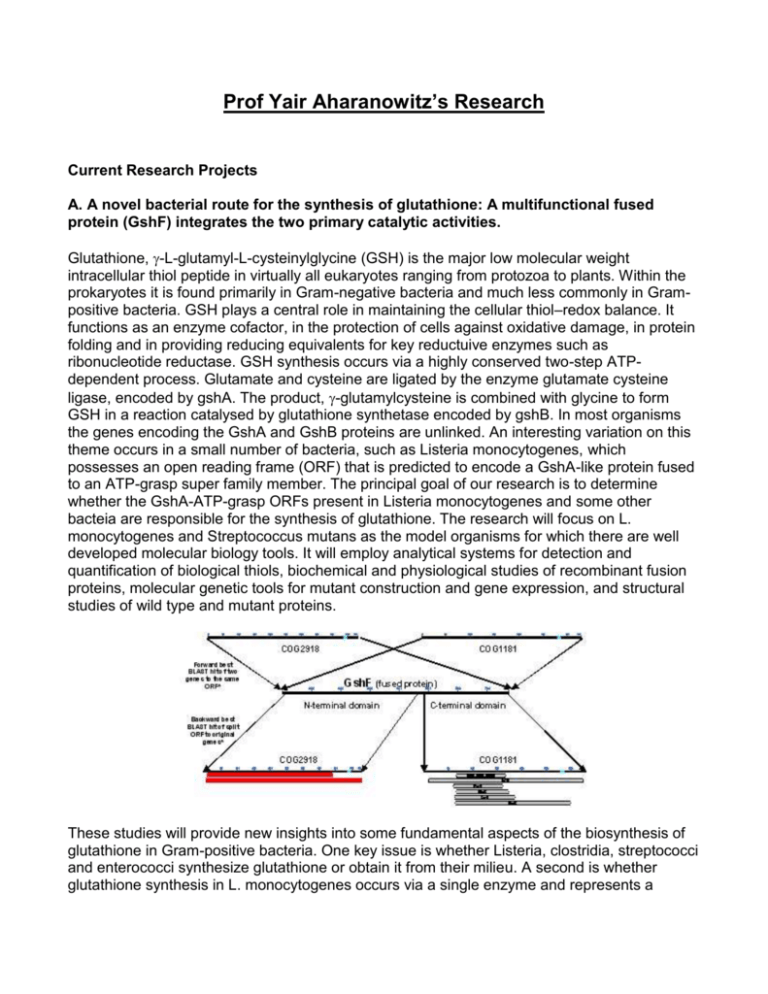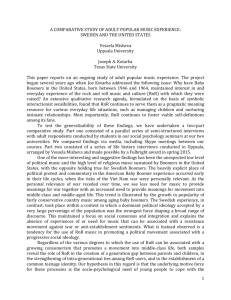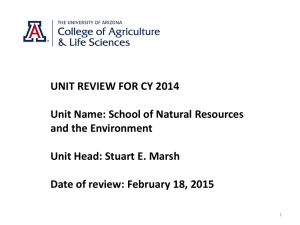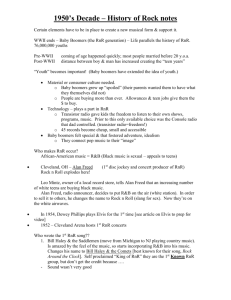Prof Yair Aharanowitz`s Research
advertisement

Prof Yair Aharanowitz’s Research Current Research Projects A. A novel bacterial route for the synthesis of glutathione: A multifunctional fused protein (GshF) integrates the two primary catalytic activities. Glutathione, -L-glutamyl-L-cysteinylglycine (GSH) is the major low molecular weight intracellular thiol peptide in virtually all eukaryotes ranging from protozoa to plants. Within the prokaryotes it is found primarily in Gram-negative bacteria and much less commonly in Grampositive bacteria. GSH plays a central role in maintaining the cellular thiol–redox balance. It functions as an enzyme cofactor, in the protection of cells against oxidative damage, in protein folding and in providing reducing equivalents for key reductuive enzymes such as ribonucleotide reductase. GSH synthesis occurs via a highly conserved two-step ATPdependent process. Glutamate and cysteine are ligated by the enzyme glutamate cysteine ligase, encoded by gshA. The product, -glutamylcysteine is combined with glycine to form GSH in a reaction catalysed by glutathione synthetase encoded by gshB. In most organisms the genes encoding the GshA and GshB proteins are unlinked. An interesting variation on this theme occurs in a small number of bacteria, such as Listeria monocytogenes, which possesses an open reading frame (ORF) that is predicted to encode a GshA-like protein fused to an ATP-grasp super family member. The principal goal of our research is to determine whether the GshA-ATP-grasp ORFs present in Listeria monocytogenes and some other bacteia are responsible for the synthesis of glutathione. The research will focus on L. monocytogenes and Streptococcus mutans as the model organisms for which there are well developed molecular biology tools. It will employ analytical systems for detection and quantification of biological thiols, biochemical and physiological studies of recombinant fusion proteins, molecular genetic tools for mutant construction and gene expression, and structural studies of wild type and mutant proteins. These studies will provide new insights into some fundamental aspects of the biosynthesis of glutathione in Gram-positive bacteria. One key issue is whether Listeria, clostridia, streptococci and enterococci synthesize glutathione or obtain it from their milieu. A second is whether glutathione synthesis in L. monocytogenes occurs via a single enzyme and represents a “primitive” form of a non-ribosomal multifunctional peptide synthetase. A third concerns the evolution of the different types of glutathione synthetase genes in Gram-postive bacteria. Finally, because this research focuses on characterizing novel biochemical and structural features of a unique protein that is found in some clinically important bacterial pathogens, for which there is no mammalian counterpart, it may prove valuable in identifying new targets for antimicrobial drug development. B. Development of new selective and essential targets for antibiotics, and their use in specific drug discovery programs. This project is based on our interest in microbial thiol-disulfide redox metabolism. Subject organisms are: Staphylococcus aureus and different Actinomycetes. The project involves the study of "Life without glutathione" in gram positive microorganisms: Characterization of a broad-range disulfide reductases and distribution of low molecular weight thiols in gram-positive microorganisms. The major objective of this project has been to identify biochemically and genetically an enzymatic system in gram-positive microorganisms that are able to carry out thiol-disulfide exchange reactions, in the absense of glutathione, and therefore maintain thiol containing peptides and proteins in their reduced thiol form. We are analyzing the in vivo role of this system for the organism by gene disruption experiments. A further objective is to verify whether the thioredoxin-like system is generally present in gram positives and whether its activity is regulated during cell growth and differentiation. The nature and relevance of the free thiol distribution and the disulfide reductase system for the biosynthesis of b-lactam antibiotics in the actinomycetes has been of particular interest to us. Studies of this kind should clarify if the thioredoxin-like reductase system has a general role in cellular metabolism as well as a particular role in b-lactam biosynthesis. C. The Ribonucleotide reductase system of Staphylococcus aureus and Streptomyces coelicolor Staphylococcus aureus is a major cause of serious diseases that has with the emergence of antibiotic resistance strains become increasingly difficult to eradicate. When S. aureus infects its host it has to cope with a variety of cellular and environmental stresses that threaten its survival. This is accomplished through a complex set of regulatory processes, which determine the synthesis of numerous proteins, many of which are virulence determinants, and which confer resistance to different stresses. The ability of S. aureus to adapt to changes in oxygen tension is a key factor in its ability to successfully colonize and propagate in its host. However, the natures of the signal transudation pathways that operate in S. aureus in response to changing oxygen tension are not well known. In this research project we plan to characterize the regulatory mechanisms used by S. aureus to adapt to changes in oxygen tension during the transition from aerobic to anaerobic growth. For this purpose we have chosen to analyze the oxygen-dependent regulation of the genes coding for ribonucleotide reductase (RNR). RNRs are essential enzymes that catalyze the reduction of ribonucleotides to deoxy- ribonucleotides for DNA replication and repair. S. aureus contains two ribonucleotide reductase gene clusters, nrdEF which determines an aerobic enzyme, and nrdDG which determines an anaerobic enzyme. We have recently shown that nrdDG is essential for anaerobic growth. Studies will be performed to a) biochemically characterize the two RNRs and determine the nature of their electron transport systems, b) analyze the Transcriptional regulation of the nrdEF and nrdDG gene clusters in terms of oxygen tension, c) identify the oxygen sensing and signal transduction systems that control nrd gene expression, d) construct reporter fusions to nrd and to virulence determinant genes to compare their regulation of expression during induction of anaerobic growth, and e) create nrd gene disruptions to establish viability in a mouse model. Attainment of these goals will, it is anticipated, provide new insights into the regulation mechanisms operating in the S. aureus aerobic-anaerobic interface. They may also validate whether the anaerobic RNR, which does not exist in the mammalian host, may serve as a valuable target for development of anti staphylococcal agents. While many of the properties of ribonucleotide reductases have been elucidated, in particular their mechanism of action and allosteric regulation, important questions remain regarding the way in which these systems are regulated at the gene level. Streptomyces determine two RNRs, a class Ia oxygen-dependent enzyme and a class II oxygen-independent enzyme, either of which is sufficient to support aerobic growth. However, the physiological circumstances in which Streptomyces employs these two systems, in vegetative growth and during morphological development, are unclear. Streptomycetes are considered to be strict aerobes that can survive for long periods in the absence of oxygen. In an attempt to define specific roles for the individual RNR systems, we examined the effect of mutations in the RNR systems on the ability of S. coelicolor to recover growth following oxygen starvation. The figure presented below shows the growth of M145, M145ΔnrdJ::apr and M145ΔnrdB::apr on solid medium following a period of three days incubation in an anaerobic chamber and subsequent exposure to aerobic conditions. No growth was visible on the plates during the anaerobic incubation. When the plates were exposed to air for one day, M145 and M145ΔnrdB::apr consistently showed substantial growth whereas M145ΔnrdJ::apr, which lacks a functional oxygen-independent RNR, showed no detectable growth. Exposure of plates to air for a further 3 days showed that M145ΔnrdJ::apr had recovered growth to the same extents as the parent M145. The groqwth curves show that similar results were obtained in experiments performed in liquid culture. The nrdJ mutant strain exhibited a pronounced lag in growth after anaerobic incubation. In our studies we explore the molecular mechanisms that control the expression of the class Ia and class II RNR genes, we are studying other regulatory factors involved in controlling the activity of the RNR system, and we anticipate that it will lead to new insights into their respective roles for growth and differentiation. The knowledge gained may prove useful in the engineering of industrial streptomycetes strains for the improved production of valuable secondary metabolites. D. Studies on control of bacterial gene expression by “riboswitch” mechanisms. “Riboswitches” are structured domains that usually reside in the noncoding regions of mRNAs, where they bind metabolites and control gene expression. Like their protein counterparts, these RNA gene control elements form highly specific binding pockets for the target metabolite and undergo allosteric changes in structure. Numerous classes of riboswitches are present in bacteria and they comprise a common and robust metabolite-sensing system (Winkler, WC., and Breaker, RR., (2005) Annu. Rev. Microbiol. 59: 487–517). We have recently shown the presence of a consensus B12 genetic control element in the approximately 350-nucleotide 5'-untranslated leader region (UTR) of the Streptomyces coelicolor nrdABS mRNA (a Class I ribonucleotide reductase (RNR) system) and speculated that its function is to enable B12 to control nrdABS expression (Borovok et al. 2004, Mol. Microbiol. 54:1022-1035). The B12 element has been one of a growing number of genetic control elements, riboswitches, that modulate gene expression in bacteria through binding of small molecules (such as vitamins, amino acids, and purines) to the 5'-UTR of mRNA to generate alternative secondary structures. The RNA sensor element embedded in the leader sequences binds the metabolite, causing repression or activation of their cognate genes. Our studies have demonstrated that the B12 riboswitch is indeed an important control element in transcriptional regulation of the Streptomyces class Ia RNR genes (Borovok et al. 2006. J. Bacteriol. 188:2512-2520). We have noted that B12 may function in a similar way to control the S. coelicolor B12-dependent and B12-independent methionine synthetases since the S. coelicolor (and some other streptomycetes) metE gene encoding the B12-independent isozyme contains a B12 riboswitch in the 5'-UTR. The Streptomyces B12-dependent class II RNR is the primary RNR system in vegetative growth and functions to enable efficient growth recovery after oxygen deprivation. The class Ia RNR system may then function as a backup system when the class II RNR is inactive, for example, when B12 biosynthesis is limiting due to insufficient availability of cobalt or B12 biosynthetic precursors releasing the B12 riboswitch from bound ligand. Taken from Borovok et al. (2006). J. Bacteriol. 188: 2512-2520











